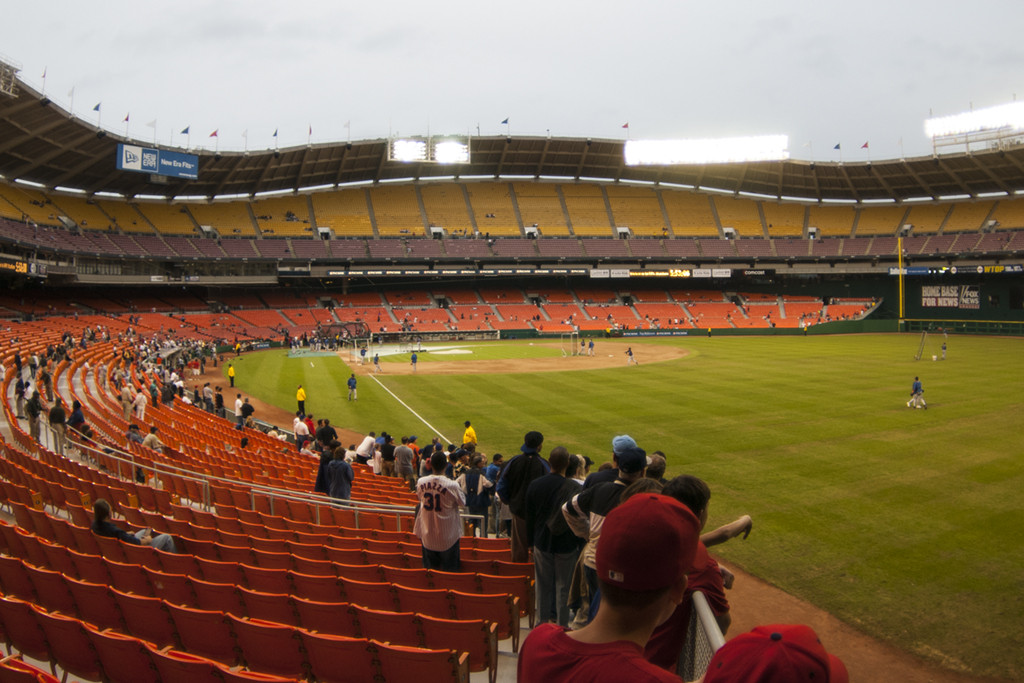
Professional sports will be back at the RFK Stadium site in the form of Washington Commanders NFL football, as the team and District of Columbia Mayor Muriel Bowser announced plans for a $2.7-billion domed stadium.
The RFK Stadium site is one of the more historic locales in professional sports. Planned in the late 1950s at a time when professional baseball and football was significantly expanding across the country, D.C. Stadium was explicitly designed as a multipurpose, reconfigurable venue for the NFL’s Washington Redskins and the expansion Washington Senators II. Over the years it also hosted a number of high-profile sports and events, including MLS’s D.C. United and the Washington Nationals after a Montreal location and before the opening of Nationals Park.
The last 1950s/1960s saw the first multiuse venues in major-league sports. D.C. Stadium opened first, on October 1, 1961, with the Washington Redskins hosting the New York Giants in a game attracting 37,767 fans to the new facility. While that number may seem small today, it was a huge improvement to how the Redskins drew at their previous home, Griffith Stadium. In terms of fan amenities, it was a huge step up from the seemingly ancient home of the Washington Senators. This was a new era in Washington, and a thoroughly modern stadium was part of that new era.
How modern? When D.C. Stadium opened (it would be renamed Robert F. Kennedy Stadium, or RFK Stadium, in 1969), it was the first multiuse, reconfigurable stadium built explicitly for pro baseball and pro football. (First to open, anyway; Shea Stadium was designed along the same lines but would not open until 1964.) Though NFL teams had played out of stadiums owned by pro baseball teams—Yankee Stadium, Wrigley Field, Tiger Stadium, Forbes Field, the Polo Grounds—the design in these ballparks was always baseball first, with football a secondary concern, and pro football even less of a consideration. Cleveland’s Municipal Stadium was built for pro baseball and secondarily for football but wasn’t a great facility for either.

The solution from George A. Dahl and Osborn Engineering was simple: a mostly circular design allowed for the movement of seating areas depending on the event, a move copied by designers of other cookie-cutter stadiums in New York City, St. Louis, Pittsburgh, Oakland, Philadelphia and Atlanta. In the case of RFK Stadium, the left-field bleachers were moved on tracks, and those bleachers became the equivalent of a stadium bouncy house. Get enough fans jumping around, and the whole stadium shook. That became part of the home-field advantage enjoyed by the Redskins during the Joe Thiesmann/Joe Gibbs area: It didn’t take that many fans to send shock waves through the stadium.
As a ballpark, RFK Stadium was an okay venue: not great, but certainly not the worst cookie-cutter stadium on the planet. The second Washington Senators never really achieved liftoff on the field or at the box office, hastily put together when Calvin Griffith moved the original Washington Senators to Minnesota for the 1961 season. You attended Sens II games for two reasons: to see Frank Howard blast a homer deep into the seats or bear witness to Ted Williams’ surprisingly successful run as manager. But after 11 years of poor attendance and unstable ownership, Bob Short engineered the 1972 move to the Dallas-Fort Worth market, leading to today’s Texas Rangers.
While cookie-cutters ended up dying out because neither football or baseball could thrive in a multi-use facility, the design actually worked at RFK Stadium. The stadium wasn’t quite a perfect circle, and the curvilinear cantilevered roof softened the views from the stands. As noted, it was the first home of the modern Senators (1962-1971) and the temporary home of the Washington Nationals (2005–2007) after the team was relocated from Montreal. In its last act it served as home of MLS’s D.C. United until 2017. It never really recovered from the loss of the Washington Commanders, however, and the lack of a robust maintenance plan and no interest in a renovation doomed the facility to demolition over the last three years.

After the demolition of RFK Stadium is complete, work will begin on the 180-acre site redevelopment with a master plan that is promised to include 5,000-6,000 housing units, parks and rec facilities, hotels, restaurants, retail and other neighborhood amenities. The stadium won’t be big—just 65,000 or so seats—and occupy just 11 percent of the site.

The centerpiece of the development is the new fixed-roof stadium, with the Washington Commanders investing a minimum of $2.7 billion. With the roof, the stadium can be used year-round for events like big concerts, international soccer friendlies and national sporting events like a Final Four or Super Bowl. This investment is billed as the largest private investment in District of Columbia history. The District will invest $1 billion in infrastructure, other site development costs, partly coming from an existing Sports Facilities Fee and the rest from a capital budget. A total of 8,000 parking spots is envisioned for the $3.7-billion development, which means big games will rely on robust Metro service at the existing Stadium-Armory station.
The early renderings, while certainly exciting for fans, are already a little disappointing: there’s no homage to the unique design of RFK Stadium, no throwback to that distinctive George A. Dahl and Osborn Engineering roofline. Earlier renderings of a new Washington Commanders stadium from Bjarke Ingels Group (BIG) featured some direct throwbacks to the RFK Stadium design; let’s hope we see some in the next round of planning.
Renderings courtesy District of Columbia and Washington Commanders.
RELATED STORIES: Next stage of RFK Stadium demolition to proceed; RFK Stadium demolition underway; RFK Stadium seats to go on sale; End of an Era at RFK Stadium; RFK Stadium future subject of meetings; RFK at 50: Will there be 50 more?; Are final days near for RFK Stadium?
